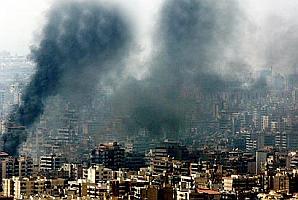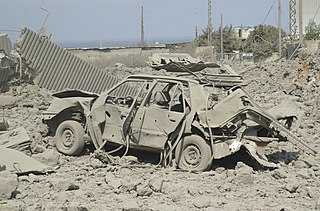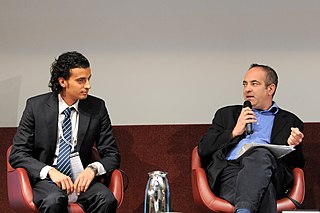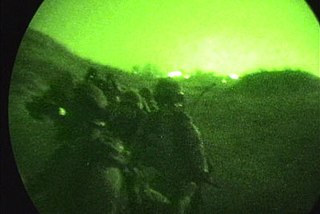 W
WThe 2006 Lebanon War, also called the 2006 Israel–Hezbollah War and known in Lebanon as the July War and in Israel as the Second Lebanon War, was a 34-day military conflict in Lebanon, Northern Israel and the Golan Heights. The principal parties were Hezbollah paramilitary forces and the Israel Defense Forces (IDF). The conflict started on 12 July 2006, and continued until a United Nations-brokered ceasefire went into effect in the morning on 14 August 2006, though it formally ended on 8 September 2006 when Israel lifted its naval blockade of Lebanon. Due to unprecedented Iranian military support to Hezbollah before and during the war, some consider it the first round of the Iran–Israel proxy conflict, rather than a continuation of the Arab–Israeli conflict.
 W
WThe Adnan Hajj photographs controversy involves digitally manipulated photographs taken by Adnan Hajj, a Lebanese freelance photographer based in the Middle East, who had worked for Reuters over a period of more than ten years. Hajj's photographs were presented as part of Reuters' news coverage of the 2006 Lebanon War, but Reuters has admitted that at least two were significantly altered before being published.
 W
WThe 2006 Qaa airstrike was an attack by the Israel Air Force (IAF) on a building in the area of al-Qaa around 10 kilometers from Hermel in the Bekaa Valley, Lebanon on 4 August 2006. The attack took place during the 2006 Lebanon War. Thirty-three farm workers, mostly Syrian and Lebanese Kurds, were killed during the airstrike.
 W
WA number of incidents of attack on civilian and UN convoys have been reported. The Israel Defense Forces has disputed involvement in some cases, and has also alleged that no prior coordination took place before some affected convoys set out. These allegations have in turn been disputed. There have also been reports that fear of aerial attack has prevented drivers from transporting humanitarian aid within Lebanon. One estimate two weeks into the conflict placed the number of Lebanese truck drivers who had died as a result of IDF/IAF air strikes on convoys as "dozens".
 W
WThe Battle of Bint Jbeil was one of the main battles of the 2006 Lebanon War. Bint Jbeil is a major town of some 20,000 inhabitants in Southern Lebanon. Although Brigadier-General Gal Hirsch announced on July 25 that the Israel Defense Forces (IDF) had "complete control" of Bint Jbeil, this statement was later discredited. In spite of three sustained attempts by the IDF to conquer the town, it remained in the hands of Hezbollah until the end of the war. The town was the scene of some of the fiercest fighting of the war, with both sides taking heavy losses. Three senior Israeli officers, including Major Roi Klein, were killed in the battle. Hezbollah similarly lost several commanders, most notably Khalid Bazzi, commander of the Bint Jbeil area.
 W
W"Canadians of convenience" is a pejorative referring to Canadian citizens with multiple citizenship who live permanently outside of Canada or remain outside the country for extended periods without "substantive ties" to Canada. Some definitions use the term to refer to persons who immigrate to Canada, meet the residency requirement to become a naturalized citizen, and then return to live in their original home country while maintaining their Canadian citizenship. The term implies that these citizens only acquire or maintain their citizenship as a form of "insurance" so that they may call on the Canadian government for protection in the event of an emergency.
 W
WDahieh is a predominantly Shia Muslim suburb composed of several towns and municipalities south of Beirut, located in the Baabda District of Lebanon. There is also a minority of coexisting Sunni Muslims, and a Palestinian refugee camp which has 20,000 inhabitants. It is located north of the Rafic Hariri International Airport, with the M51 Freeway that links Beirut to the Airport passing through it. Prior to the 2006 Israel-Lebanon conflict, Dahieh was a residential and commercial area with malls, stores and souks.
 W
WFrom the Wilderness and Lebanon - An Israeli soldier's story of war and recovery is the English translation of the first book by Israeli author Asael Lubotzky.
 W
WThe 2006 Ghaziyeh airstrikes also referred to as the 2006 Ghaziyeh massacre were two sequential attacks by the Israel Air Force (IAF) on the city of Ghaziyeh in Lebanon on August 7, and August 8, 2006. The attacks took place during the 2006 Lebanon War. In the first attack on August 7, the IAF bombed a building killing 16 people. In the second attack on August 8, the IAF fired five missiles into three buildings killing a total of 8 to 14 civilians and wounding 33. A total of 26 to 30 civilians died in the attacks.
 W
WEhud "Udi" Goldwasser was an Israeli soldier who was abducted in Israel by Hezbollah along with Eldad Regev on 12 July 2006, sparking the 2006 Lebanon War. His rank was First Sergeant.
 W
WTom Gross is a British-born journalist, international affairs commentator, and human rights campaigner specializing in the Middle East. Gross was formerly a foreign correspondent for the London Sunday Telegraph and New York Daily News. He now works as an opinion journalist and has written for both Arab and Israeli newspapers as well as European and American ones, both liberal and conservative. He also appears as a commentator on the BBC and various Middle Eastern networks.
 W
WINS Hanit is a Sa'ar 5-class corvette of the Israeli Navy, built by Northrop Grumman Ship Systems in 1994. On 14 July 2006, during the 2006 Lebanon War, it suffered damage after being struck by a Hezbollah C-802 anti-ship missile.
 W
WHaret Hreik is a mixed Shia and Maronite Christian municipality, in the Dahieh suburbs, south of Beirut, Lebanon. It is part of the Baabda District. Once an agricultural village, Haret Hreik lost its rural identity due to the wave of refugees from Southern Lebanon who settled in the town and made it another urban neighborhood of Dahieh.
 W
WInternational reactions to the 2006 Qana airstrike, which saw the greatest loss of civilian life in the 2006 Israel-Lebanon conflict, twenty eight deaths with thirteen missing, largely involved the condemnation of Israel by many countries around the globe, bringing about a supposed 48 hours cessation of air operations by the Israeli Air Force. Bombings resumed only a few hours after the start of the cessation of air operations.
 W
WThe 2006 Israeli reserve soldiers' protest was a protest movement which called for the resignation of the government and the establishment of a state commission of inquiry into what they argued were crucial failures experienced during the 2006 Israel-Lebanon conflict. From late August to early October 2006, some of its followers were stationed in a tent city besides the Israeli government building, and several large demonstrations were carried out to protest against the conduct of the government before, during, and after the war.
 W
WThe Jiyeh Power Station oil spill is an environmental disaster caused by the release of heavy fuel oil into the eastern Mediterranean after storage tanks at the thermal power station in Jiyeh, Lebanon, 30 km (19 mi) south of Beirut, were bombed by the Israeli Air force on July 14 and July 15, 2006 during the 2006 Israel-Lebanon conflict. The plant's damaged tanks leaked up to 30,000 tonnes of oil into the eastern Mediterranean Sea, A 10 km wide oil slick covered 170 km of coastline, and threatened Turkey and Cyprus. The slick killed fish, threatened the habitat of endangered green sea turtles, and potentially increased the risk of cancer.
 W
WThe Lebanese Resistance Brigades is a non-denominational Lebanese paramilitary group affiliated with Hezbollah. The irregular militia is composed of Sunni Muslims, Christians, Druze and non-practicing Shiites who subscribe to anti-Israel beliefs. The Resistance Brigades are funded, trained, armed, and founded by Hezbollah. The group's manpower, composition, and strength are unclear.
 W
WDuring the 2006 Lebanon War, a number of international incidents occurred in Lebanon, largely involving United Nations personnel in Lebanon, who have come under a number of attacks. On 25 July 2006, four unarmed United Nations Truce Supervision Organization (UNTSO) peacekeepers were killed during an Israeli air strike on a UN observation post in southern Lebanon. Israel motivated the attack as wrong identification of target as a militant enemy post.
 W
WDr. Asael Lubotzky is a former Israel Defense Forces officer wounded in combat, who has become an Israeli physician, author and molecular biologist.
 W
WThe 2006 Lebanon War, also called the 2006 Israel–Hezbollah War and known in Lebanon as the July War and in Israel as the Second Lebanon War, was a 34-day military conflict in Lebanon, Northern Israel and the Golan Heights. The principal parties were Hezbollah paramilitary forces and the Israel Defense Forces (IDF). The conflict started on 12 July 2006, and continued until a United Nations-brokered ceasefire went into effect in the morning on 14 August 2006, though it formally ended on 8 September 2006 when Israel lifted its naval blockade of Lebanon. Due to unprecedented Iranian military support to Hezbollah before and during the war, some consider it the first round of the Iran–Israel proxy conflict, rather than a continuation of the Arab–Israeli conflict.
 W
WThe Mudeirej Bridge or Mdairej Bridge is a bridge in Lebanon. It was completed in 1998 as the tallest and highest bridge in Lebanon and the Middle East but this has since been surpassed. The bridge was built as part of Rafik Hariri's vision of rebuilding and developing Lebanon and its infrastructure. The bridge served as a connecting route for the Beirut-Damascus Highway aiming to improve the main road that links Syria's capital city Damascus, to Lebanon and its capital city Beirut.
 W
WLebanon's position in the 2006 Israel–Lebanon conflict from the start was to disavow the Hezbollah shelling and raid on 12 July, while calling for an immediate ceasefire and the withdrawal of all Israeli forces from Lebanese territory.
 W
WThe Qana airstrike was an air strike carried out by the Israeli Air Force (IAF) on a three-story building in the small community of al-Khuraybah near the South Lebanese village of Qana on July 30, 2006, during the 2006 Lebanon War. 28 civilians were killed, of which 16 were children. Israel halted air strikes for 48 hours following the attack, amid increasing calls for a cease-fire in the conflict between Israel and Lebanon's Hezbollah guerrillas.
 W
WEldad Regev was an Israeli soldier abducted by Hezbollah fighters along with Ehud Goldwasser on 12 July 2006 in Israel near the Lebanese border, sparking the 2006 Lebanon War. His rank was Sergeant First Class.
 W
WThe Chyah Airstrike or the Chyah Massacre was an attack by the Israel Air Force (IAF) on the Shiyyah suburb in the Lebanese capital of Beirut on August 7, 2006, during the 2006 Lebanon War. Two missiles fired from an IDF bomber destroyed three apartment buildings in the suburb. Contemporary news accounts stated that the death toll from the airstrikes rose as recovery efforts continued, with 50 corpses recovered at the time of reportage and 61 anticipated.
 W
WThe Siniora Plan was the unofficial name of the 7-point truce plan for the 2006 Lebanon War that was presented by Lebanon's Prime Minister Fuad Siniora at the 15-nation conference in Rome on 27 July 2006.
 W
WKeren Tendler was Israel's first female helicopter flight mechanic soon after a court allowed women to serve in combat positions.
 W
WThe Tyre raid was a night mission by the Israel Defense Forces naval commando unit, Shayetet 13, in Tyre, South Lebanon, on August 5, 2006. The target was an apartment building, allegedly housing Hezbollah leaders responsible for the rocket attack on Hadera a day earlier. The entire operation lasted 1 hour and 45 minutes.
United Nations Security Council Resolution 1680, adopted on May 17, 2006, after recalling previous resolutions on Lebanon, including 425 (1978), 426 (1978), 520 (1982), 1559 (2004) and 1655 (2005), the Council strongly encouraged Syria to respond positively to Lebanon's request to delineate borders and establish diplomatic relations, with the purpose of asserting Lebanon's sovereignty, territorial integrity and political independence.
 W
WThe 2006 Hezbollah cross-border raid was a cross-border attack carried out by Lebanon-based Hezbollah militants on an Israeli military patrol on 12 July 2006 on Israeli territory.